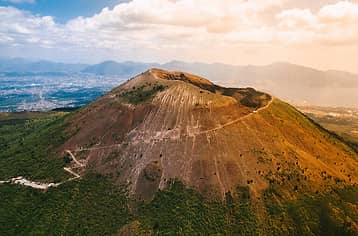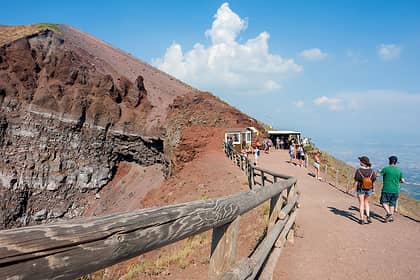- Home
- Experiences
- Visiting Mount Vesuvius
Visiting Mount Vesuvius


Mount Vesuvius is arguably the most famous peak in southern Italy, one of only two active volcanoes (the other is the nearby Phlegraen Fields located in the same region of Campania) still active in Continental Europe. Soaring almost 4,000 feet (1,200 meters) above the Bay of Naples, this volcano looms over the city of Naples, its coastline, and islands in the bay. Its name can probably be traced back to the Indo-European term eus, which means "to burn", and today it is the centerpiece of the Vesuvius National Park.
The last eruption of Mt. Vesuvius was in March of 1944; since then it has remained dormant but geologists warn that it could become active and damage the area with a volcanic eruption again at any time. Because of its explosive eruptions and huge concentration of people living in the immediate vicinity, it is one of the most dangerous volcanoes in the world and the volcanic activity is continuously monitored by a team of scientists from the Vesuvius Observatory so nearby residents can be warned of a major eruption ahead of time.
The devastating Plinian eruption of Vesuvius in 79 AD (named after Pliny the Younger who narrated the event to the historian Tacitus) completely destroyed the Roman cities of Pompeii and Herculaneum, burying them under a thick pyroclastic flow of volcanic ash, mud, and lava and consigning them to history forever. Since then, Mt. Vesuvius has been a major figure in shaping Italian history and literature, occupying a unique space in the collective imagination of Neapolitans and all Italians.
Visiting Mt. Vesuvius
Visiting Mt. Vesuvius

Mt. Vesuvius is one of the most famous and spectacular natural attractions in southern Italy, and a visit to its volcanic crater, known as the “Gran Cono”, is a must if you’re visiting Naples, Sorrento, or the Amalfi Coast. Not only can you learn about the geothermal history of the Somma-Vesuvius volcanic system from the national park guides, but you can also admire breathtaking views over the city of Naples, the ruins of Pompeii, and the Bay of Naples island of Ischia, Capri, and Procida. From atop Mt. Vesuvius, you can also take in sweeping views of Punta Nasone and the Mount Somma caldera, which was once part of a single volcanic system.
You must purchase a national park ticket to climb Mt. Vesuvius and tickets are only available online and not at the on-site park office. Take trail number 5 to the "Gran Cono", either on your own or with one of the park’s official volcanologist guides for insights into the volcano’s past eruptions and current activity. Once you reach the crater’s edge, you are free to take in the views from the path, stop to take photos, have a bite to eat, or browse the souvenir shops.
Mt. Vesuvius Visits and Tours
Mt. Vesuvius Visits and Tours
The Gran Cono trail is open every day of the year, and closes to the public only in case of bad weather. The opening hours change seasonally.
Hours
January, February, November, and December: 9 a.m. - 3 p.m.
March and October: 9 a.m. - 4 p.m.
April, May, June, and September: 9 a.m. - 5 p.m.
July and August: 9 a.m. to 6 p.m.
There is a park office (formerly the ticket office) at an altitude of 1,000 meters. Parking was once available here, but now visitors must park at the official parking areas located at a lower elevation and take the shuttle bus to the trailhead.
Ticket Prices
€10: regular tickets
€8: youth under 25 (with ID)
Free: children under 6 (with ID) and disabled visitors with an assistant
If you’d rather not deal with the hassle of arranging transportation, parking, and tickets, opt for a Mt. Vesuvius tour. There are both private and group options that depart from a number of nearby locations (Naples, Sorrento, the Amalfi Coast, and others) and often include a stop at a nearby farm or winery for a food and wine tasting or other experience.
When is the Best Time to Visit Mt. Vesuvius?
When is the Best Time to Visit Mt. Vesuvius?
The best seasons to visit Mt. Vesuvius are spring and early autumn, when the temperatures are ideal and the sun is pleasantly warm. In May and June, the volcanic slopes are blanketed with colorful wildflowers and the sky is generally clear, offering endless views and great photo ops.
In July and August, the heat and lack of share are difficult to bear on the uphill path and crater’s edge. If you are planning on visiting Mt. Vesuvius in the height of summer, bring a bottle of water, a sun hat, and high-coverage sunscreen with you.
Winter can be a good time to visit Mt. Vesuvius without the crowds, especially if you take advantage of the sunny days and mild temperatures in southern Italy. Given the altitude, however, you can encounter snow…be sure to wear warm clothing and shoes.
No matter what the season, avoid rainy days if possible since the ground is covered in volcanic rocks like pumice that becomes slippery when wet.
Hiking Trails on Mt. Vesuvius
Hiking Trails on Mt. Vesuvius
The Grand Cono trail is the most famous and popular hiking route on Mt. Vesuvius, as it leads directly to the crater’s edge. There are a number of alternative trails on the slopes of the volcano for hiking enthusiasts who want to take on Continental Europe’s only active volcano, however, that offer excellent views without the crowds. There are 11 trails inside the parkland of varying difficulty, including the new trail n. 11 Pineta di Terzigno, which is wheelchair accessible. The Valle dell’Inferno and Riserva Tirone are two of the most challenging walking routes for expert hikers, while trail n. 9 that begins near the Ottaviano Observatory leads over hardened lava flows that are now covered in wildflowers, shrubs, and lichens.
Trails on Mt. Vesuvius are often closed for maintenance work or due to weather conditions, so always check the official Vesuvius National Park site before planning your excursion.
Getting to Mt. Vesuvius
Getting to Mt. Vesuvius
From Naples:
Though it provides the backdrop to the city, Mt. Vesuvius is located outside the municipality of Naples so you need to leave the city to visit the volcano.
From Naples to Mt. Vesuvius with public transportation
To reach Mt. Vesuvius from downtown Naples, take the Circumvesuviana train from the lower level of the Stazione Centrale train station in Piazza Garibaldi. You have to get on the train to Sorrento (make sure you get on the right route!) and get off at the Ercolano Scavi or Pompei Villa dei Misteri stations. Shuttle buses depart from here and go up to the Gran Cono trailhead (the ticket costs €22 round trip, including entrance to the Vesuvius National Park). From the Pompei station, public EAV buses depart for Mt. Vesuvius every 50 minutes, in addition to the shuttle. Otherwise, hire one of the taxis from the official taxi stand just outside the train station to reach the trailhead.
Pompeii - Mt. Vesuvius bus schedules
From Naples to Mt. Vesuvius by car
If you are getting around by car, you can reach the top of Mt. Vesuvius by taking the A3 Napoli Salerno motorway. Exit at Ercolano or Torre del Greco, continue along Via Cupa Monti and Via Vesuvio, following the signs for the National Park.
You must park in one of the official lots along the road that climbs towards the summit, managed by the Municipality of Herculaneum. Parking costs €6 and can be reserved online.
After parking, walk up to the Gran Cono entrance at 1,000 meters altitude or take the shuttle that departs from the parking area. Tickets can be purchased on site and cost €2 round trip (children ride free). We suggest opting for the shuttle to avoid the 30-minute uphill walk that can be a challenge, especially on a hot day!
From Sorrento:
From Sorrento, take the Circumvesuviana train towards Naples and get off at the Ercolano Scavi or Pompei Villa dei Misteri station. From here you can continue with the shuttle or by taxi (or by public bus from Pompeii). If you are driving, take the SS145 motorway towards Castellammare di Stabia, exit at Castellammare, and then follow the signs for the National Park along Via Cupa Monti. At around 800 meters altitude, you will find the authorized parking areas and the shuttle to the ticket office.
Naples - Sorrento Circumvesuviana train schedules
From Herculaneum:
To reach Vesuvius from the excavations of the ancient city of Herculaneum, take the tourist shuttle from the Circumvesuviana station of Ercolano Scavi to the Gran Cono ticket office. You can also opt for a faster but more expensive taxi.
From Pompeii:
The cheapest way to get to the top of Mt. Vesuvius from the ruins of the Roman city of Pompeii is the bus from the Circumvesuviana station of Pompei Villa Dei Misteri. There are also taxi services and group tours that depart daily from the archaeological site.
Where to Stay Near Mt. Vesuvius
Where to Stay Near Mt. Vesuvius
Although Mt. Vesuvius can be reached quite easily from Naples, Sorrento, and its surroundings, you may want to stay closer. There are a wide variety of farmhouse accommodations, country residences, and B&Bs located right on the mountain slopes. Good locations to search include San Sebastiano al Vesuvio, Ottaviano, and Ercolano. The coastal town of Torre Annunziata is also a convenient base. This town is located along the Naples - Sorrento rail line that stops at a number of seaside resorts in the Gulf of Naples.
Visiting Pompeii and Mt. Vesuvius in One Day
Visiting Pompeii and Mt. Vesuvius in One Day

Delve into the history of Mt. Vesuvius and the mark it has left on the area’s history and landscape by spending a day exploring the volcano and the ancient city it destroyed in 79 AD with a combined Vesuvius + Pompeii day.
To visit the excavations of Pompeii you will need at least three hours, so we suggest first hiking up to the Gran Cono in the morning and then visiting the archaeological site in the afternoon. You can take a break for lunch at a vineyard located on the slopes near both attractions.
To avoid wasting time between buses, shuttles, or parking lots, you can book a combined tour including transport:
Visiting Herculaneum and Mt. Vesuvius in One Day
Visiting Herculaneum and Mt. Vesuvius in One Day
The archaeological site of Herculaneum is less well known than its neighbor Pompeii, but just as interesting. This is a smaller site, so takes less time to visit and is less tiring.
You can easily visit Herculaneum on the same day you explore Mt. Vesuvius, using either public transportation or joining a tour.
FAQ - Frequently asked questions
How much do you pay to visit Mount Vesuvius?
The ticket to visit the Gran Cono trail costs € 10 for adults and € 8 for under 25s. Admission is free for the disabled and accompanying persons.
When can Mt Vesuvius erupt?
It is not possible to predict or estimate the time of the next eruption of Mount Vesuvius, but the volcano is constantly monitored by expert geologists and volcanologists.
What is the current state of Mount Vesuvius?
Mt Vesuvius is an active but dormant volcano. Currently, the volcanic activity of Vesuvius does not raise particular concerns and is constantly followed by experts from the Vesuvius Observatory.
Why is Mount Vesuvius the most dangerous volcano in the world?
Mt Vesuvius is considered the most dangerous volcano in the world because its activity gives rise to very violent explosive eruptions and because a large number of inhabitants live at the base of the volcano.
When did Mount Vesuvius last explode?
The last eruption of Mt Vesuvius dates back to March 1944.